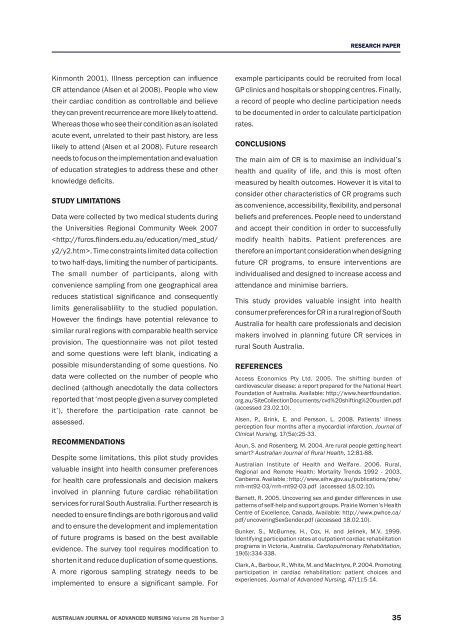australian journal of advanced nursing
australian journal of advanced nursing
australian journal of advanced nursing
Create successful ePaper yourself
Turn your PDF publications into a flip-book with our unique Google optimized e-Paper software.
Kinmonth 2001). Illness perception can influence<br />
CR attendance (Alsen et al 2008). People who view<br />
their cardiac condition as controllable and believe<br />
they can prevent recurrence are more likely to attend.<br />
Whereas those who see their condition as an isolated<br />
acute event, unrelated to their past history, are less<br />
likely to attend (Alsen et al 2008). Future research<br />
needs to focus on the implementation and evaluation<br />
<strong>of</strong> education strategies to address these and other<br />
knowledge deficits.<br />
STUDY LIMITATIONS<br />
Data were collected by two medical students during<br />
the Universities Regional Community Week 2007<br />
. Time constraints limited data collection<br />
to two half‑days, limiting the number <strong>of</strong> participants.<br />
The small number <strong>of</strong> participants, along with<br />
convenience sampling from one geographical area<br />
reduces statistical significance and consequently<br />
limits generalisablility to the studied population.<br />
However the findings have potential relevance to<br />
similar rural regions with comparable health service<br />
provision. The questionnaire was not pilot tested<br />
and some questions were left blank, indicating a<br />
possible misunderstanding <strong>of</strong> some questions. No<br />
data were collected on the number <strong>of</strong> people who<br />
declined (although anecdotally the data collectors<br />
reported that ‘most people given a survey completed<br />
it’), therefore the participation rate cannot be<br />
assessed.<br />
RECOMMENDATIONS<br />
Despite some limitations, this pilot study provides<br />
valuable insight into health consumer preferences<br />
for health care pr<strong>of</strong>essionals and decision makers<br />
involved in planning future cardiac rehabilitation<br />
services for rural South Australia. Further research is<br />
needed to ensure findings are both rigorous and valid<br />
and to ensure the development and implementation<br />
<strong>of</strong> future programs is based on the best available<br />
evidence. The survey tool requires modification to<br />
shorten it and reduce duplication <strong>of</strong> some questions.<br />
A more rigorous sampling strategy needs to be<br />
implemented to ensure a significant sample. For<br />
RESEARCH PAPER<br />
example participants could be recruited from local<br />
GP clinics and hospitals or shopping centres. Finally,<br />
a record <strong>of</strong> people who decline participation needs<br />
to be documented in order to calculate participation<br />
rates.<br />
CONCLUSIONS<br />
The main aim <strong>of</strong> CR is to maximise an individual’s<br />
health and quality <strong>of</strong> life, and this is most <strong>of</strong>ten<br />
measured by health outcomes. However it is vital to<br />
consider other characteristics <strong>of</strong> CR programs such<br />
as convenience, accessibility, flexibility, and personal<br />
beliefs and preferences. People need to understand<br />
and accept their condition in order to successfully<br />
modify health habits. Patient preferences are<br />
therefore an important consideration when designing<br />
future CR programs, to ensure interventions are<br />
individualised and designed to increase access and<br />
attendance and minimise barriers.<br />
This study provides valuable insight into health<br />
consumer preferences for CR in a rural region <strong>of</strong> South<br />
Australia for health care pr<strong>of</strong>essionals and decision<br />
makers involved in planning future CR services in<br />
rural South Australia.<br />
REFERENCES<br />
Access Economics Pty Ltd. 2005. The shifting burden <strong>of</strong><br />
cardiovascular disease: a report prepared for the National Heart<br />
Foundation <strong>of</strong> Australia. Available: http://www.heartfoundation.<br />
org.au/SiteCollectionDocuments/cvd%20shifting%20burden.pdf<br />
(accessed 23.02.10).<br />
Alsen, P., Brink, E. and Persson, L. 2008. Patients’ illness<br />
perception four months after a myocardial infarction. Journal <strong>of</strong><br />
Clinical Nursing, 17(5a):25‑33.<br />
Aoun, S. and Rosenberg, M. 2004. Are rural people getting heart<br />
smart? Australian Journal <strong>of</strong> Rural Health, 12:81‑88.<br />
Australian Institute <strong>of</strong> Health and Welfare. 2006. Rural,<br />
Regional and Remote Health: Mortality Trends 1992 ‑ 2003.<br />
Canberra. Available : http://www.aihw.gov.au/publications/phe/<br />
rrrh‑mt92‑03/rrrh‑mt92‑03.pdf (accessed 18.02.10).<br />
Barnett, R. 2005. Uncovering sex and gender differences in use<br />
patterns <strong>of</strong> self‑help and support groups. Prairie Women’s Health<br />
Centre <strong>of</strong> Excellence, Canada, Available: http://www.pwhce.ca/<br />
pdf/uncoveringSexGender.pdf (accessed 18.02.10).<br />
Bunker, S., McBurney, H., Cox, H. and Jelinek, M.V. 1999.<br />
Identifying participation rates at outpatient cardiac rehabilitation<br />
programs in Victoria, Australia. Cardiopulmonary Rehabilitation,<br />
19(6):334‑338.<br />
Clark, A., Barbour, R., White, M. and MacIntyre, P. 2004. Promoting<br />
participation in cardiac rehabilitation: patient choices and<br />
experiences. Journal <strong>of</strong> Advanced Nursing, 47(1):5‑14.<br />
AUSTRALIAN JOURNAL OF ADVANCED NURSING Volume 28 Number 3 35

















